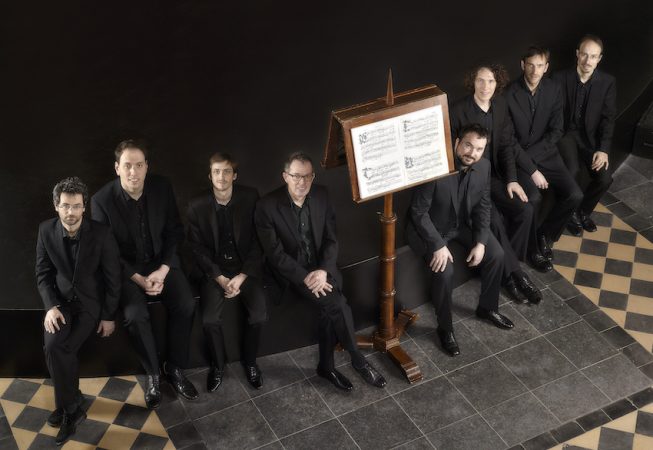Cappella Pratensis finds a rewarding convergence with Desprez, Mouton
There’s not much new under the sun. In music, advances in instrument technology, performance technique, and notational methods have been a process of gradual evolution for the most part. There have been few true transformative moments in music history outside of the creation of music notation and the invention of audio recording technology; the present and future are directly linked to foundations laid centuries ago, and even synthesizers and computer music languages are extended developments of ideas that have been in practice for a long, long time.
Sunday afternoon’s lovely Music Before 1800 concert in Corpus Christi Church with Cappella Pratensis, an all-male vocal ensemble from the Netherlands, reminded one of these foundational elements.
Cappella Pratensis specializes in the music of Josquin Desprez, the towering figure of Renaissance polyphony, and their program featured Josquin along with his near-exact contemporary, the far lesser known French composer Jean Mouton. There was a loose sense of occasion, a belated acknowledgment of the 500th anniversary of their deaths in 1521 and 1522 respectively, but the main focus was musical, in that both composers were key figures in developing canonic polyphony is mass settings.
This was a musicological idea that the ensemble described in the program and also with a brief lecture, after opening with a gentle, shining performance of Josquin’s motet Inviolata, integra et casta. Motet and canon blended into each other, both historically and in the concert. In general terms, the polyphony of a motet was based on repeating and imitating the main idea, with variations, in different voices, while the canon codified polyphony under a set of rules that, through practice, became more specific and exacting through time, evolving into fugue. The motet brought Medieval music into the Renaissance, and the canon brought Renaissance music into the baroque era.
Even to the experienced ear, the difference between a motet and canon in vocal performance is elusive to the point of non-existence. Instrumentation has a lot to do with this, as strict counterpoint is easy to pick out on a keyboard, but with a vocal group as fine as this one, one was easily caught up in the grain and timbre of the voices.
The music is meant to be expressive and beautiful, with singing full of inflection and emotion, moments of compelling resonance for singers and listeners as the voices briefly flowed together onto the tonic and then smoothly wound away again. Singing this music at a high level demands considerable style, and rhythmic freedom from inner voices, embellishment and even some improvisation on top of the statement of the plainchants that are the literal grounds for masses all came out with a sense of freedom.
Cappella Pratensis put the “Agnus Dei” from Mouton’s Missa Tua est potentia and Josquin’s wonderful Missa Ave maris stella in sequence, the group gathered around and singing from one large choir book, as if it were indeed 500 years ago. Each plainchant statement was followed by a glorious sensation of the music flowering, unfolding petal by petal and voice by voice. Though Josquin and Mouton—who was an important figure in his day—were setting out what they felt were the rules of proper composition, they wrote their masses to transfix the assembled congregation, instantiating them with the Holy Spirit, and that was the effect Sunday. The canons were the vehicles, and the ensemble’s skill and insight delivered.
This was not all liturgy—they sang two of Josquin’s secular songs. In a way, this was to show that the master used his canonic rules in all sorts of singing, but one was rather more interested in hearing lines that translated as “The penniless have to lay low, since sleeping / women will only wake for cash” sung with the same smooth, delicate luminosity of the masses and motets, and thinking how 50 years ago this would have been doo-wop.
There was slightly more Josquin than Mouton, though the finale was the latter’s robust, earthy Nesciens mater. It was fascinating to hear the stylistic differences between the two. There is speculation that Mouton might possibly have studied with Josquin; though against Josquin’s style, which always seems to be terracing itself upward, floating higher even as the key stays where it is, Mouton had the longer, deliberate, ropey lines of his predecessor Jacob Obrecht. Neither is greater nor less than the other and Sunday they were two marvelous examples of ideas so useful and meaningful that they’ve stayed with us for 500 years.
The Tiburtina Ensemble concludes Music Before 1800’s current season with “Celestial Beauty: Hildegard of Bingen,” 4 p.m. May 7. mb1800.org
